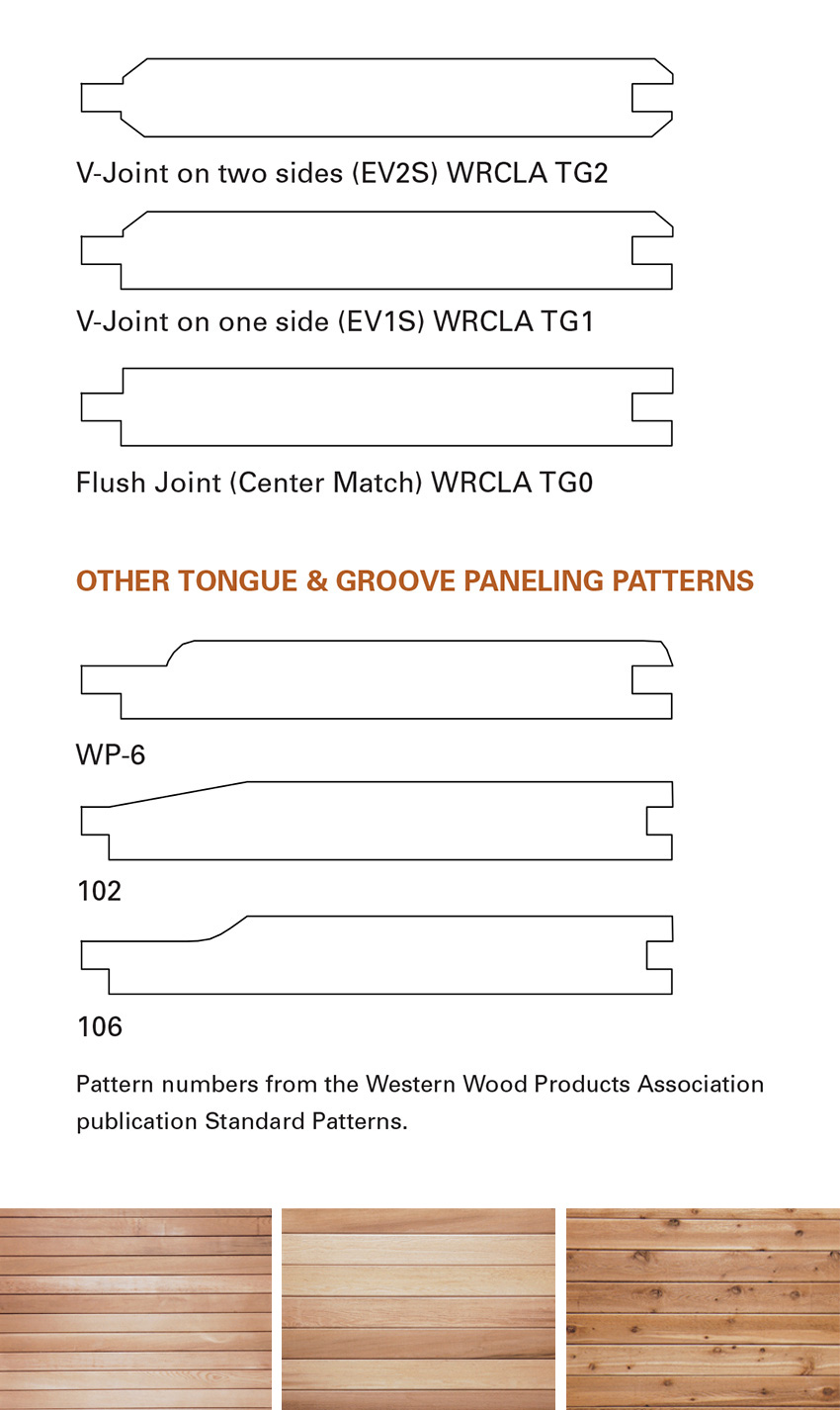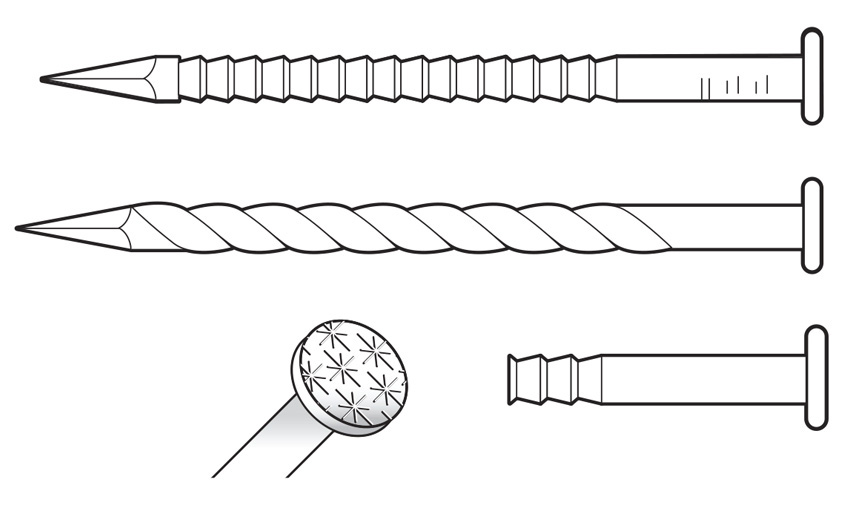How to Design With and Specify Western Red Cedar Siding
Choices of Siding Profiles
When using cedar siding on a building project, the design process can include selecting a siding type and grade based on our discussion thus far, but the next step is to choose a preferred profile. As a wood product, WRC can be milled or shaped into many different profiles related to the type of siding selected. The WWPA and WRCLA have published a listing of “Standard Patterns” showing specific profiles and shapes. Some of the most common ones are reviewed here, but others are available, including custom profiles by WRCLA manufacturers.
- Beveled siding: Beveled siding can be milled in a standard beveled shape or can include a rabbeted drip edge along the bottom of the siding. Clear beveled siding is available in thickness of ½ inch, 11/16 inch, and ¾ inch and widths of 4, 6, 8, 10, and 12 inches depending on the specific grade. Plain bevel, knotty grade siding is available in thicknesses of 5/8 inch, 11/16 inch, ¾ inch, and 7/8 inch, and widths of 6, 8, 10, or 12 inches. Rabbeted bevel knotty siding is generally thicker at 11/16 inch, ¾ inch, or 5/4 inch, and in widths of 6, 8, 10, and 12 inches. The very rustic looking wavy edge bevel siding is also typically a thicker and wider product at 7/8- and 15/16-inch thicknesses and 8-, 10-, and 12-inch widths.

Some standard tongue and groove profiles that are available in grades of Clear Heart, A Clear, or Select Knotty as shown above.
- Patterned siding: While tongue and groove or lap siding profiles are fairly common among different wood products, there are some subtle details to the shape of the boards that can have a noticeable design impact. In tongue and groove siding, for example, the shape of the protruding tongue and the recessed groove to receive it from an adjacent piece are fairly standardized to be functional. However, the area right around either of these shapes influences the finished appearance. Flush joint (center matched) patterns produce a tight, monolithic appearance. A V-joint on one or both sides of the tongue and the groove edges provides a different visual look. Other shapes along these edges, like fine line (1/8 inch) are possible too, to provide more variety in the way that lines of the siding are portrayed. In virtually all cases, however, nominal 1-inch thick boards are available in 4-, 6-, 8-, and 10-inch widths.
Lap siding profiles can vary a great deal to provide some very interesting and unique three-dimensional looks. They are also shaped to assure a good overlapping joint that will provide the appropriate weather resistance for siding. As such, they are available in a variety of thicknesses to suit the three-dimensional appearance sought, ranging from a fairly flat or thinner profile to a thicker, simulated “log cabin” look. Regardless of the thickness and the details of the lap pattern, most lap siding is available in 6-, 8- 10-, and 12-inch widths.
- Vertical Siding: As noted earlier, not all siding should be used in vertical configurations. Bevel siding profiles are not appropriate for this installation, even when rabbeted, but board and batten siding works well in vertical designs. Tongue and groove and lap profiles are specifically created to provide interlocking or overlapping joints that make them suitable for all orientations, whether horizontal, vertical, or angled.
- Cedar for Rainscreens: An increasingly popular installation method is to use a rainscreen over a continuous water and air barrier applied to a substrate sheathing. The concept, well proven for many types of buildings, is to allow the outer cladding to “breathe” and allow moisture to drain harmlessly to ground below via gravity. That process requires a gap between the cladding and the barrier to function properly. Western red cedar siding of almost any profile can be used as the cladding in a rainscreen wall assembly, provided it is installed over something to create that needed gap and not directly to the sheathing. The most common method is to use vertical furring strips that are secured over the barriers and into the sheathing and framing at appropriate spacing. The siding is then installed onto the furring strips, creating the needed gap and allowing water and air to flow behind the siding as needed.
In some cases, rainscreens, or even conventional wall assemblies, include continuous rigid foam insulation over the sheathing substrate. This has implications for the installation of the cedar siding and recommended practices published by the WRCLA or the supplier of the siding should be consulted.
Fasteners for Cedar Siding
All siding and cladding products require proper fastening as a critical component for proper performance and appearance over time, and western red cedar siding is no different. On this point, there are some very well developed best practices that should be followed whenever cedar siding is used to assure the intended results are achieved.
The first thing to be aware of is that hand nailing of cedar is recommended instead of pneumatic nailing. This protects the appearance and helps prevent damage from improperly set pressures on nailing guns. The second, and always critical point when working with wood, is the fastener spacing. Typically the spacing for studs or nailing framework is a maximum of 24 inches on center, with 16 inches being common. Nails need to be selected in a size that allows them to penetrate into framing members, not just the sheathing, a minimum of 1¼ inches. The actual size of the fasteners is thus based on the type and thickness of the cedar siding used.


Fastening is an important detail for the successful installation of all types of cedar siding with “splitless” ring shank siding nails of appropriate thickness and length to suit the siding type used.
The actual fasteners require some attention to detail in specifications and in the installation of cedar siding. High quality “splitless” ring shank siding nails are recommended for proper holding power. Textured heads are also recommended to reduce any glossy appearance of the nail head. Stainless steel is the best choice—number 304 stainless for general siding applications and number 316 for seacoast exposures. These are the least likely to corrode and cause visual or performance issues. Hot-dipped galvanized nails as per ASTM A-153 or aluminum fasteners are also corrosion-resistant and can be used as well if preferred. Electroplated and mechanically galvanized fasteners are not recommended since they can rust, disintegrate, or react adversely with the natural preservative present in cedar, thus resulting in stains and streaks.









